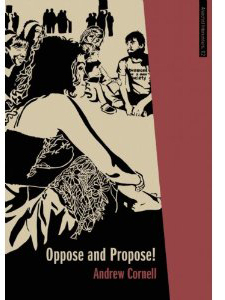Resistance Community
 Oppose and Propose! Lessons from Movement for a New Society
Oppose and Propose! Lessons from Movement for a New Society
By Andrew Cornell
AK Press, 2011, 200 pages, $12
In the early 1990s, my comrade Melissa and I visited our first War Resisters League National Committee meeting. As young pacifists and anarchist communists, we felt isolated in the wider anarchist movement. WRL drew us in with its history of anarchists and socialists who, like us, saw pacifism as central to lasting revolution.
What impressed us most at the meeting was the complex consensus process called a spokescounsel, where power flowed from coordinated small groups to a synthesis process. Here was an organization that was resisting the war state, and its consensus seemed to prefigure the anarchist society.
This book provided me with a context to my first WRL experience with consensus. It traces the history of the Movement for a New Society (MNS), which first popularized this kind of complex consensus in the 1980s, from which, in many ways, the anarchist peace culture we encountered was a direct descendant.
Oppose and Propose! is divided into a historical narrative, interviews with George Lakey and other MNS peace veterans, historical documents, and a conclusion.
MNS, Cornell writes, was a resistance community founded in Philadelphia in 1971. It was a radical outgrowth of a Quaker antiwar group and quickly came to encompass a far-reaching vision of integrating resistance and alternative institution building. The intention from the outset was to be a living laboratory of consensus process, intentional community, and radical resistance to war and imperialism. How far any of these were successful, or led to internal problems, is the heart of the book. Learning from our own history seems to be one of the author’s main motivations.
In the life of MNS, the successes loom large, including its powerful influence on the antinuclear movement and the successful blockade of a military ship in Baltimore Harbor in 1971.
One of the major threads of the book is how MNS incorporated old and new consensus techniques into its work and pushed the possibilities of such a process to its limits. While consensus was originally a galvanizing force in MNS, there was a sense that it led to a certain rigidity. Toward the end, a basic introductory flyer to MNS, to be revised by full consensus, took two years to update!
Tensions
One former member describes how tensions grew between activists and community builders. Some perceived MNS as being too “Philly-centric” at the expense of being an effective national movement. Also, MNS originated out of a largely Quaker peace culture that was predominantly white and middle class. Although there were notable members of color, the organization, despite its best intentions, remained locked in that history and largely failed to make itself relevant to activists of other histories. By 1988, these various tensions had taken their toll on the organization, and MNS, by consensus, laid itself down.
Cornell observes that after MNS was laid down, its legacy lived on, most notably in the anarchist and antiauthoritarian left. Although most anarchist organizers today may not embrace radical nonviolence, Cornell contends that the best parts of the MNS legacy are felt in these organizers’ principled use of consensus process and affinity groups, with a sense that our decision process today should reflect the direct democracy of the future. He claims that the long shadow of MNS can be found in the great moment of the WTO uprising of 1999.
My desire to read this book stemmed mostly from my interest in anarchist pacifism. When I heard that the book was concerned with anarchism, I was a little skeptical, wondering if the author would be reading anarchism “into” an essentially liberal action group, based on its use of civil disobedience.
But to my delight, the author makes a concise and clear case that anarchism was specifically part of the culture of MNS, that its founders were often very taken, for example, by Murray Bookchin’s Post-Scarcity Anarchism. He looks at the various papers put forward by MNS, which make very clear that as an organization, MNS was oriented toward a decentralized socialism and antinationalism, as well as a clear critique of capitalist economics as incompatible with nonviolence. Leading up to this, by way of background history, is a nice summary of the anarchist pacifist tradition, including war resisters imprisoned during WWII who worked to desegregate the prisons, a cast of characters that intersects with WRL’s own history.
Overall, this book fills in a lost chapter of anarchist pacifist history and is a goldmine of information about the strengths and weaknesses of the MNS legacy.



